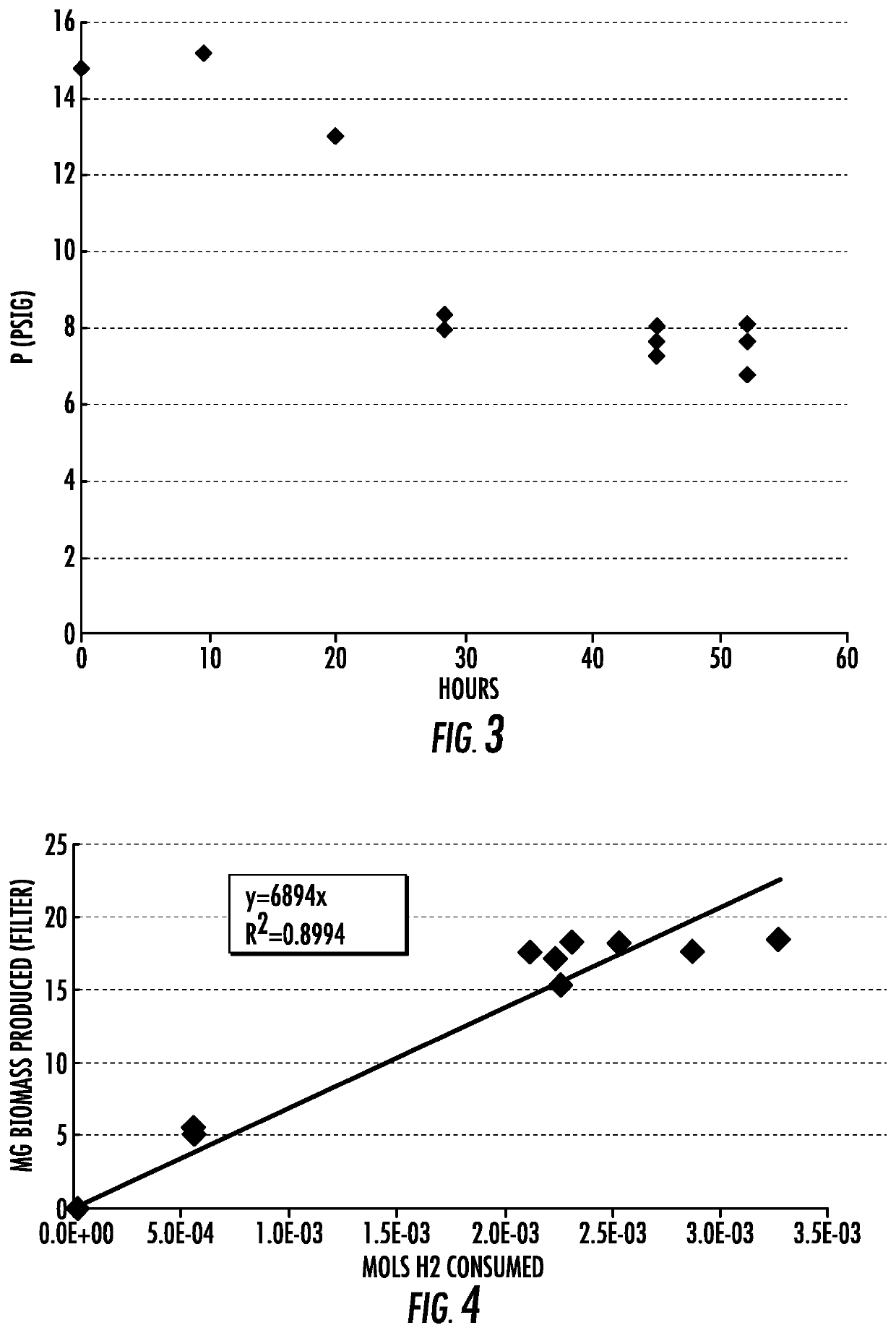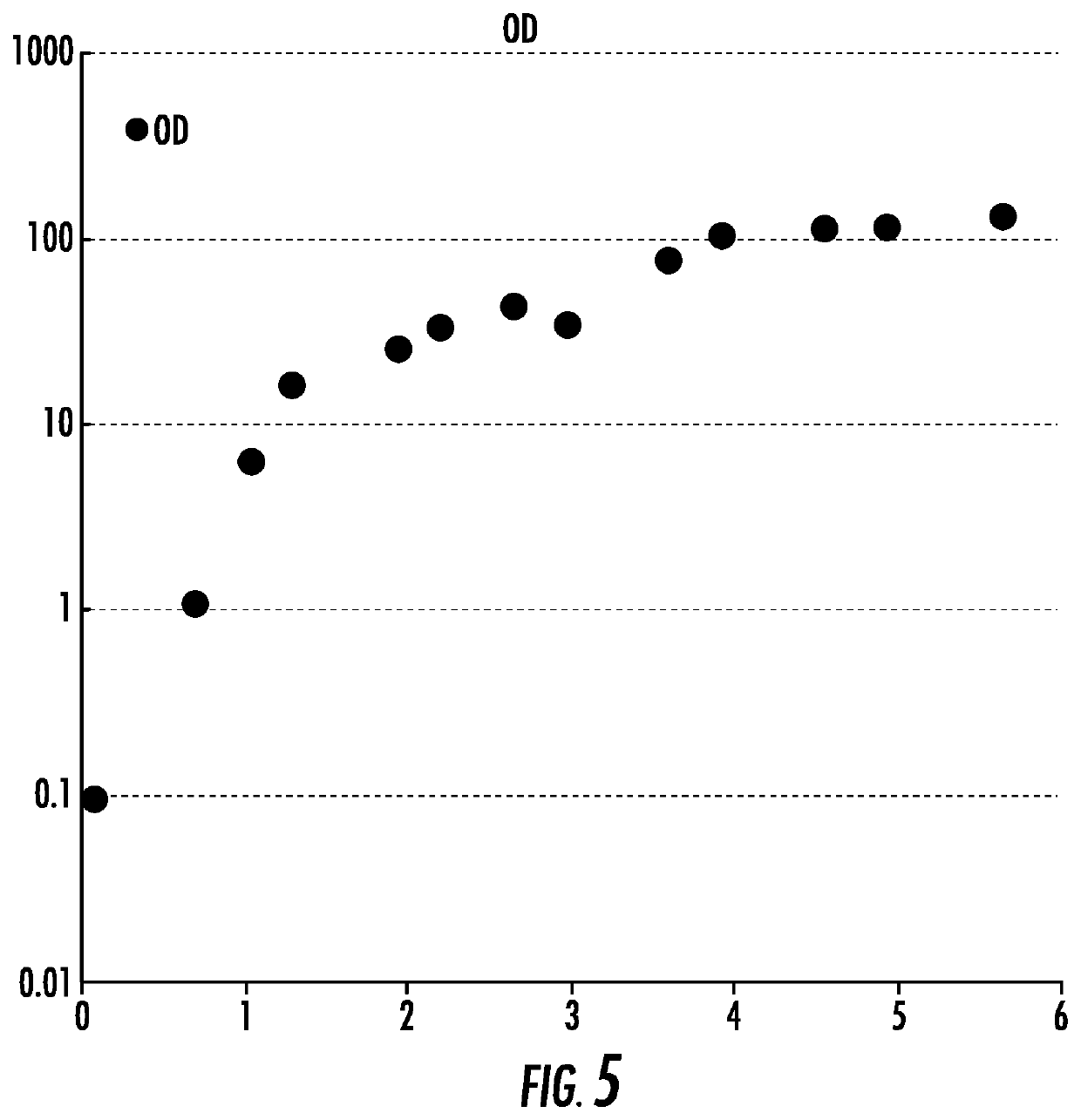Microbial Conversion of CO2 and Other C1 Substrates to Vegan Nutrients, Fertilizers, Biostimulants, and Systems for Accelerated Soil Carbon Sequestration
a technology of co2 and other c1 substrates, applied in the field of chemistry applied in agriculture, can solve the problems of heterotrophic fermentations being vulnerable to contamination, unable to meet the needs of heterotrophic fermentations, and unable to meet the needs of mycorrhizal fungi, and achieve the effect of improving the ability of mycorrhizal fungi
- Summary
- Abstract
- Description
- Claims
- Application Information
AI Technical Summary
Benefits of technology
Problems solved by technology
Method used
Image
Examples
example 1
[0438]Cupriavidus necator strain DSM 531 was grown on a mixture of H2 and CO2 and O2 gases as the sole source of energy and carbon for growth.
[0439]The following protocol was followed for experiments performed using a mixture of gases in gas tight serum bottles.
[0440]Experimental inoculum: 5% by volume, taken from another H2 grown serum bottle culture.
[0441]The initial H2 grown serum bottle culture was in turn given 5% inoculation from a Lysogeny broth (LB) grown Cupriavidus necator inoculum, and grown ˜72 hours on H2 / CO2 / O2 gas mix following inoculation from original LB grown culture. Original LB grown inoculum was recovered from glycerol stock stored at −80° C.
[0442]Serum bottle growth on gas was performed in 160-ml stoppered and sealed Wheaton glass serum bottles (VWR product number 16171-385). Volume of liquid media was 20 ml. The bottles were plugged with a rubber stopper (VWR #100483-774) and aluminum seal (VWR #89047-008) using Wheaton Hand-Operated Crimper (VWR #80078-996). ...
example 2
[0449]Cupriavidus necator strain DSM 531 was grown to 38 grams per liter dry cell density on a mixture of H2, CO2, and O2 gases as the sole source of energy and carbon for growth.
[0450]The following protocol was followed for experiments performed using a mixture of gases including H2, CO2, and O2 in a stirred-tank bioreactor.
[0451]Apparatus: Culture was grown in batch, using a custom-manufactured 500 mL glass fermenter with PEEK headplate. Temperature and pH were controlled and monitored with a commercial controller (Electrolab, Fermac 360, United Kingdom). A combination of magnetic stir bars and continuous recycle at 280 mL / min were used for mixing. Recycle could be either withdrawn from the bottom liquid section of the reactor and returned to the headspace through sprayers to control foaming or run in reverse to recycle the headspace gas and foam into the bottom of the broth. Gas supply was from compressed H2, compressed CO2 and house air, each regulated to 20 psi. H2 and air were...
example 3
Inoculation and Growth Conditions
[0458]Organisms from the genus Rhodococcus and from the genus Cupriavidus were tested for their ability to grow on different carbon sources (FIG. 6). Colonies from strains grown on LB agar plates at 30° C. were transferred into flasks containing 10% (v / v) of the indicated media (i.e. heterotrophic or chemoautotrophic) for 3-20 days at 30° C. and 250 rpm. R. opacus strain DSM 44193 exhibited growth only under heterotrophic growth conditions as measured by optical density (OD) at 650 nm on MSM medium (1 L Medium A: 9 g Na2HPO4.12H2O, 1.5 g H2PO4, 1.0 g NH4Cl and 0.2 g MgSO4.7H2O per 1 L; 10 ml Medium B: 50 mg Ferric ammonium citrate and 100 mg CaCl2) per 100 ml; 10 ml Medium C: 5 g NaHCO3 per 100 ml; and 1 ml Trace Mineral Solution: 100 mg ZnSO4.7H2O, 30 mg MnCl2.4H2O, 300 mg H3BO3, 200 mg CoCl2.6H2O, 10 mg CuCl2.2H2O, 20 mg NiCl2.6H2O and 30 mg Na2MoO4.2H2O per 1 L) supplemented with 40 g / L glucose. R. opacus strain DSM 43205 showed identical growth r...
PUM
| Property | Measurement | Unit |
|---|---|---|
| Fraction | aaaaa | aaaaa |
| Fraction | aaaaa | aaaaa |
| Volume | aaaaa | aaaaa |
Abstract
Description
Claims
Application Information
 Login to View More
Login to View More - R&D
- Intellectual Property
- Life Sciences
- Materials
- Tech Scout
- Unparalleled Data Quality
- Higher Quality Content
- 60% Fewer Hallucinations
Browse by: Latest US Patents, China's latest patents, Technical Efficacy Thesaurus, Application Domain, Technology Topic, Popular Technical Reports.
© 2025 PatSnap. All rights reserved.Legal|Privacy policy|Modern Slavery Act Transparency Statement|Sitemap|About US| Contact US: help@patsnap.com



